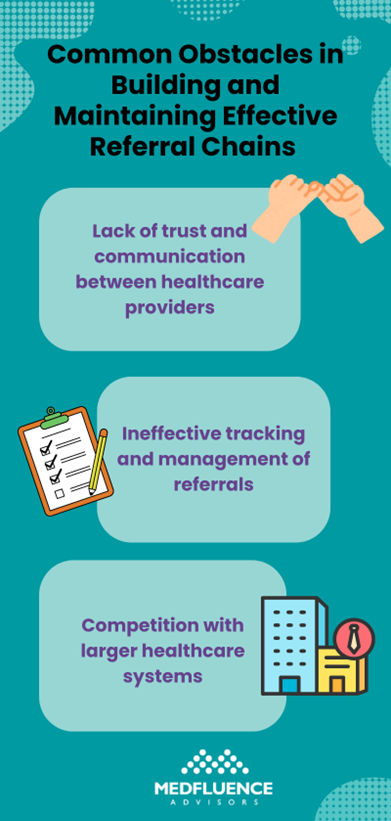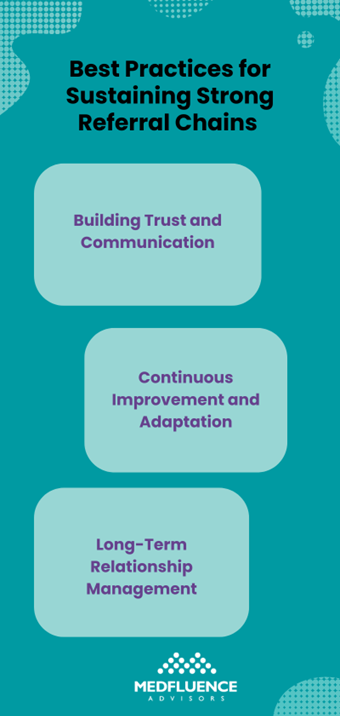Referral Chains in Private Practice

Growing a private practice isn’t easy these days. The old ways of getting new patients just don’t cut it anymore. With big healthcare systems gobbling up market share and everyone jumping on the digital marketing bandwagon, smaller practices can feel lost in the shuffle.
But there’s one strategy that still packs a punch: referral chains. These networks of trust between healthcare pros are the secret sauce of successful practices. The catch? Building and keeping these connections is trickier than ever.
In this case study, we’re looking into why referral chains matter so much for private practices today. We’ll look at the roadblocks many practices hit when trying to build these networks, show you how some clever marketing moves can breathe new life into your referral system, and give you concrete steps to beef up your practice’s referral game.
Whether you’re scratching your head over how to keep a steady stream of patients coming through your door, or just want to fine-tune your referral process, this guide’s got your back. We’ll help you stand out in a crowded field and keep your practice thriving.
The Concept of Referral Chains in Private Practice
Referral chains are networks of professional relationships between healthcare providers who refer patients to one another based on their specific needs. In private practice, these chains are the backbone of patient acquisition and continuity of care.
Essentially, when one physician identifies a patient’s need that falls outside their expertise, they refer the patient to a trusted colleague who specializes in that area. This process creates a chain of referrals that ensures patients receive comprehensive care while keeping them within a network of providers who collaborate closely.
The importance of referral chains in private practice cannot be overstated. They not only facilitate the seamless transfer of patients between specialists but also foster trust and collaboration among healthcare providers.
For patients, this means receiving the best possible care from professionals who are well-versed in their specific conditions.
For practices, it translates to a steady flow of new patients, strengthened professional relationships, and a reputation for comprehensive, patient-centered care.
The Role of Referral Chains in Patient Acquisition
Unlike other marketing strategies that target a broad audience, referral chains target specific, high-quality patient leads who are already seeking specialized care. When a patient is referred, they come with a built-in level of trust, both in the referring physician and the practice they are being referred to.
This trust simplifies the patient acquisition process. Instead of spending resources on broad-reaching marketing campaigns, practices can focus on nurturing and expanding their referral networks. A well-maintained referral chain can lead to a consistent inflow of patients who are more likely to stick with the practice long-term, reducing the need for aggressive marketing tactics and increasing patient retention.
Moreover, referral chains contribute to building long-term patient relationships. When a patient is referred within a trusted network, they are more likely to feel cared for and understood. This personalized approach not only enhances patient satisfaction but also increases the likelihood of further referrals, both from the patients themselves and from other providers.
Evolution of Referral Chains
Referral chains have long been a staple of private practice, but like many aspects of healthcare, they have evolved significantly over time. In the past, referral chains were primarily built on personal relationships and word-of-mouth recommendations. Physicians who had established trust with one another would refer patients back and forth, often without the need for formal agreements or tracking systems.
However, as the healthcare landscape has shifted, so too have referral chains. The rise of digital marketing, electronic health records (EHRs), and data analytics has transformed how referrals are made and managed. Today, practices are increasingly using digital tools to track and optimize their referral networks, ensuring that every referral is followed up on and that patient outcomes are monitored more closely.
Additionally, the competitive nature of modern healthcare has driven practices to be more strategic in building their referral chains. It’s no longer enough to rely solely on personal relationships; practices must now actively cultivate and manage their referral networks, often using targeted marketing efforts to attract and maintain relationships with other providers.
Challenges in Building and Maintaining Effective Referral Chains
Common Obstacles
Building and maintaining effective referral chains is not without its challenges. Despite their importance, several common obstacles can hinder the development of a robust referral network in private practice.
1. Lack of Trust and Communication Between Healthcare Providers
Trust and communication are the cornerstones of any successful referral chain. However, establishing and maintaining these relationships can be difficult, especially in a competitive healthcare environment. When providers do not trust each other’s expertise or patient care standards, they may hesitate to make referrals, weakening the chain. Additionally, poor communication between referring and receiving providers can lead to missed opportunities, misunderstandings, and a breakdown in the continuity of care. This lack of trust and communication can prevent the referral chain from functioning effectively, ultimately impacting patient outcomes and the practice’s reputation.
2. Ineffective Tracking and Management of Referrals
Managing referrals manually or without a proper system can lead to inefficiencies and lost opportunities. Without effective tracking, it’s easy for referrals to fall through the cracks, resulting in patients not receiving timely care and practices missing out on potential revenue. Additionally, without proper management, it can be challenging to measure the success of referral relationships or identify areas for improvement. Practices that do not have a streamlined system for managing and following up on referrals may struggle to maintain a steady patient inflow, ultimately weakening their referral chain.
3. Competition with Larger Healthcare Systems
Small to midsize private practices often face stiff competition from larger healthcare systems that have more resources to invest in marketing, technology, and patient acquisition strategies. These larger systems can create extensive referral networks within their own organizations, making it harder for independent practices to attract referrals. Additionally, larger systems often have more bargaining power when it comes to forming partnerships with other providers, further limiting opportunities for smaller practices to build and sustain their referral chains. The pressure to compete with these larger entities can make it difficult for private practices to maintain effective referral networks.

Impact of Digital Transformation
The digital transformation of healthcare has introduced both opportunities and challenges in the realm of referral chains. While technology has the potential to streamline and enhance referral processes, it has also disrupted traditional referral methods and introduced new complexities.
1. How Digital Marketing and Online Presence Have Disrupted Traditional Referral Chains
The rise of digital marketing and the growing importance of an online presence have changed how patients choose healthcare providers. In the past, patients often relied heavily on referrals from their primary care physicians or specialists.
Today, however, many patients conduct their own research online, using reviews, ratings, and other digital resources to make healthcare decisions. This shift has disrupted traditional referral chains, as patients may bypass the referral process altogether in favor of providers they discover online.
While this change offers practices new opportunities to attract patients directly, it also poses a challenge to maintaining the referral relationships that have traditionally driven patient acquisition.
2. The Challenge of Maintaining Personal Connections in a Digital World
Digital tools have made it easier to manage and track referrals, but they have also made it more challenging to maintain the personal connections that are essential for a strong referral chain.
The reliance on emails, EHR systems, and automated communication can lead to a more transactional relationship between providers, rather than the trust-based relationships that have historically underpinned successful referral chains.
As communication becomes more digital, the personal touch that fosters trust and collaboration can be lost, making it harder to build and sustain effective referral networks. Practices must find a balance between leveraging digital tools and maintaining the personal relationships that are critical for long-term success in referral management.
Transforming Referral Chains for Small to Midsize Practices
Let’s explore the journey of several small to mid-size private practices that were struggling to attract and retain patients. These practices, diverse in their specialties but united by a common challenge, faced significant difficulties in building and maintaining effective referral chains.
Initial Situation and Challenges
At the outset, the practices involved in this case study were facing considerable challenges. Despite offering high-quality care, they struggled with patient acquisition, primarily due to weak referral networks. Referrals that were once a reliable source of new patients had dwindled, leaving the practices dependent on costly and often ineffective marketing campaigns. The traditional methods of networking and building relationships with other healthcare providers were no longer yielding the same results, largely due to increased competition from larger healthcare systems and the disruptive impact of digital transformation.
For these practices, the weak referral chains resulted in inconsistent patient inflows, making it difficult to sustain operations and plan for growth. The lack of a robust referral system also led to missed opportunities for patient care, as potential patients were either lost in the shuffle or directed to larger systems with more established networks. Without a strategic approach to rebuilding their referral chains, these practices were at risk of further decline.
Implementation of New Strategies
Recognizing the urgency of the situation, our team developed and implemented a tailored approach to rebuild and strengthen the referral chains for these practices. Our strategy focused on two key areas: enhancing professional relationships and integrating innovative marketing strategies and technologies.
1. Rebuilding Trust and Communication
We began by conducting a thorough analysis of the existing referral networks, identifying key gaps and opportunities for improvement. Our team then facilitated targeted outreach efforts, reconnecting the practices with other healthcare providers in their local communities.
This included organizing joint professional events, offering continuing education opportunities, and establishing regular communication channels to foster trust and collaboration. By focusing on rebuilding these relationships, we helped to re-establish the referral chains that are vital for patient acquisition.
2. Integrating Innovative Marketing Strategies and Technologies
To complement the relationship-building efforts, we introduced a range of innovative marketing strategies and technologies designed to streamline the referral process and attract new patients.
This included the implementation of a referral management system that allowed the practices to efficiently track and follow up on referrals, ensuring no patient was overlooked.
We also leveraged digital marketing tools, such as targeted online campaigns and search engine optimization (SEO), to enhance the online presence of the practices and drive patient inquiries. These efforts were carefully coordinated to ensure that the practices not only rebuilt their referral networks but also expanded their reach in the digital space.
The Role of Innovative Marketing in Enhancing Referral Chains
Effective referral chains require a harmonious blend of both traditional referral methods and digital marketing strategies. Traditional methods, such as building relationships with fellow healthcare providers through face-to-face interactions, professional networking events, and direct communication, remain invaluable for establishing trust and long-term partnerships. These connections, often built over years, foster a reliable referral network.
However, digital marketing plays an increasingly critical role in supplementing these traditional approaches. Tools like email marketing, social media outreach, and digital networking platforms allow practices to maintain continuous contact with referral partners while expanding their visibility to potential new sources of referrals.
Digital solutions like referral management software help automate the process of tracking and managing referrals, ensuring no patient slips through the cracks. Blending these approaches enables private practices to strengthen their referral chains by reaching more providers and streamlining communication.
The power of data cannot be underestimated in modern referral chain management. Data-driven decision-making allows practices to track the effectiveness of referral efforts, analyze trends, and identify potential gaps in the referral process.
Using data analytics tools, practices can gain insight into which referral sources are most effective, where patient acquisition is strongest, and which providers may need additional attention to strengthen the referral relationship.
For instance, tracking referral patterns can help identify areas where a practice is losing potential patients, whether due to communication breakdowns or inefficient processes. By analyzing these trends, practices can adjust their strategies in real time, ensuring that referral chains are continuously optimized.
Additionally, leveraging data enables practices to create personalized outreach strategies for referral partners, demonstrating an understanding of their needs and preferences, which helps solidify long-term relationships.
Best Practices for Sustaining Strong Referral Chains
Building Trust and Communication
One of the most critical elements of a successful referral chain is trust. Practices must consistently engage in open, honest communication with their referral partners to foster strong, reliable relationships. Building this trust starts with transparency—keeping referral partners informed about patient outcomes, being receptive to feedback, and demonstrating a commitment to providing high-quality care. Regular check-ins and updates help ensure that referring providers feel confident in sending patients to the practice, knowing that their patients are in good hands.
Continuous Improvement and Adaptation
Referral strategies should never remain static. To maintain effectiveness, practices must continually review their referral networks, evaluate their success, and be willing to make adjustments when necessary. Regularly assessing which referral sources are most active, analyzing patient outcomes, and exploring new marketing trends can help identify areas of opportunity for growth. Additionally, keeping up with changes in healthcare policies, industry trends, and patient behavior will ensure that referral strategies remain relevant and effective over time.
Long-Term Relationship Management
Maintaining strong, long-term relationships with referral sources requires ongoing effort. Practices should prioritize regular communication, whether through personalized outreach or digital updates, to ensure that referral partners feel valued. Celebrating successes, sharing patient stories, and collaborating on new ways to enhance patient care can help solidify these relationships. By treating referral partners as key stakeholders in the practice’s success, practices can create a referral network that remains strong for years to come.

Strengthen Your Referral Chain Today for a Thriving Practice

In today’s competitive healthcare landscape, building and maintaining strong referral chains is key to long-term success. By fostering trust with your referral partners, embracing both traditional and digital marketing strategies, and leveraging data-driven insights, you can create a reliable, continuous patient flow while enhancing care.
Start implementing these best practices now to ensure your practice stands out, grows sustainably, and continues delivering top-notch, patient-centered care.
The time to strengthen your referral network is now—don’t wait to secure your practice’s future!


